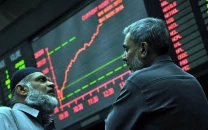Accountability in aid: World Bank downgrades anti-poverty programme
Pakistan Poverty Alleviation Fund gets its lowest rating in 12 years.

The Pakistan Poverty Alleviation Fund seems to be losing momentum. The $250 million programme was recently downgraded by the World Bank in a report issued by the Washington-based lender’s supervisory mission.
The anti-poverty program was downgraded to ‘moderately satisfactory’, the lowest grade it has received in 12 years. It had previously been rated ‘satisfactory’. The current PPAF, the third since the program began, was launched in 2009.
The loan has been given to help provide access to credit to the lowest income strata, improving access to municipal services and construction of health and school facilities in the communities inhabited by the lowest income groups. The World Bank has set the targets to expand microcredit coverage to 230,000 new borrowers and increase the ratio of female borrowers from one-fifth to one-fourth of the total borrowers.
The PPAF was established in 1999 to expand access to microcredit in the country. It has been targeting districts that score low on the Human Development Index (HDI) besides working for livelihood enhancement in food insecure pockets of the country.
The $90 million PPAF-I was launched in 2000 and was deemed “highly satisfactory”. At the end of PPAF-I, the World Bank approved PPAF-II to build on the past achievements. This was also rated “highly satisfactory”. So far the World Bank has approved $890 million for the PPAF.
Despite the downward revision in the rating, the PPAF management insists that it is still one of the best foreign-funded organisations in the country.
Ahmad Jamal, senior group head at the PPAF, said that the next World Bank mission was scheduled to review the project in February and the management has already started working to cover the grey areas.
“A change in the top management at PPAF and an expansion in the scope of activity slowed down the pace of work,” said Jamal. The government has replaced Kamal Hayat with Qazi Azmat Isa as the CEO of the entity. Isa has worked at the World Bank.
Jamal said that during better part of this year the PPAF was formulating new strategy aimed at expanding the PPAF scope to conflict and disaster-hit areas from an apex microcredit institution. He said the new management wanted to have an in-depth strategic review of the past 12 years’ performance. Thus, the PPAF stopped the process of striking new partnerships in absence of clear and coherent strategy.
“The PPAF would now give priority to conflict and disaster hit areas of the country”, he added.
Jamal said that despite the slowdown in the overall pace of work, disbursements from international donors were on track. According to the PPAF’s financial report, by the end of September 2011, the total PPAF’s cumulative disbursements stood at Rs95.6 billion. Out of that, disbursements on credit and enterprise development accounted for 58% of total disbursements followed by relief, rehabilitation and reconstruction activities.
The WB has also made it mandatory for the PPAF to administer a poverty scorecard before giving new small loans to ensure the better results.
The PPAF’s determined poverty scorecard number is 23 while the Benazir Income Support Programme – the flagship social safety net of the government – gives assistance to any individual who obtains 16 scores. The lowest score indicates extreme poverty.
For the BISP the government has earmarked Rs50 billion for the current financial year. However, the institution remains unable to disburse the amount accordingly. Up to November, BISP has disbursed Rs15 billion, said Finance Secretary Waqar Masood, adding that by the end of December, BISP would be able to disburse Rs20 billion.
Published in The Express Tribune, December 21st, 2011.



















COMMENTS
Comments are moderated and generally will be posted if they are on-topic and not abusive.
For more information, please see our Comments FAQ